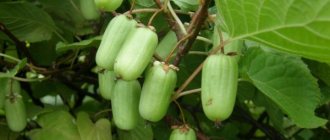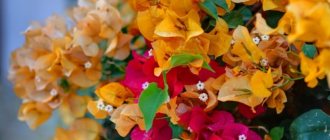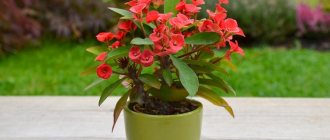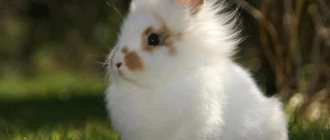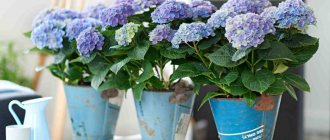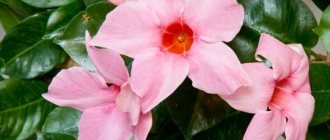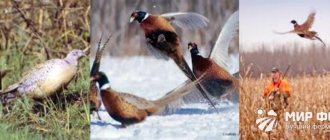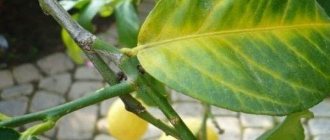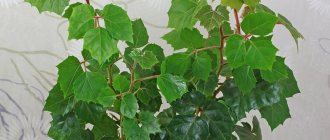Description of the plant
The abelia shrub belongs to the Honeysuckle family, subfamily Linnaeaceae. The shrub's homeland is considered to be East Asia and Mexico.
The plant, depending on the variety, can be either deciduous or evergreen. The average height of the shrub ranges from 1.5 to 2.5 meters; subject to ideal maintenance conditions, it can reach 6 meters.
The leaves are oval in shape with pointed ends and are arranged in pairs on the shoot. The crown color is dark green and shiny. The shape of the flowers varies for each variety. They can be tubular, bell-shaped or funnel-shaped, always consisting of five petals. Size - from small to extra large. The color range is all shades of pink, red and purple, but there are also absolutely white flowers. Peduncles are always located at the tips of the shoots.
All inflorescences, regardless of the variety, have a distinct, pleasant aroma.
After flowering ends, the leaves fall from the tips of the branches (along with the flower stalks). In their place, bright red sepals appear, which remain on the bush until the first frost.
What are the difficulties when growing and maintaining abelia?
When growing, certain difficulties may arise. This is a possible fall of leaves at low temperatures. Drying of abelia due to direct sunlight. Lack of flowering in low light conditions.
Insects that harm the plant include aphids, thrips, scale insects, and spider mites. Each case will require its own methods of struggle. An infusion of citrus peels helps against aphids. When the aphids have already spread along the shoots, special preparations are used. Washing with laundry or green soap also helps. Thrips are treated with the drug Actellik. Spider mites are controlled using acaricides. A decoction of cyclamen tubers is also effective. Scale insects are eliminated with the drug Aktara.
Among abelia diseases, powdery mildew is the most common. She is not susceptible to other “illnesses” so often. The disease is expressed in white spots that appear on the surface of the leaf. Fungicides are used for control. Leaves and shoots affected by dew are first removed.
Abelia is a wonderful ornamental plant that can decorate your home interior. The shrub is unpretentious in care; the main problems arise in the cold. In winter, it is necessary to maintain the room temperature below room temperature. With proper care and maintenance conditions, the plant blooms every year. Her flowers smell great and look beautiful. Abelia grows in a short time and quickly produces shoots. Usually blooms in the first year of life.
Types and varieties
The genus Abelia has about 30 varieties and species, most of which grow in natural conditions.
One species is used as a houseplant - Abelia grandiflora.
Abelia grandiflora
Another name is Grandiflora. A hybrid form that includes several varieties that differ in the shade of the inflorescences. The leaves are dark green with a glossy sheen. During the winter months their hue changes to bronze-red. The flowers are very large - up to 6 cm in diameter.
Abelia chinensis
The species is distinguished by the abundance of flowers in inflorescences. Their shade can be anything: from soft pink to deep red. The leaves are medium-sized, dark green with a slight burgundy tint.
Abelia profusely blooming
A species that is suitable for growing not only outdoors, but also in a greenhouse. Blooms profusely from early May to late September. The peduncles are large (up to 4 cm), deep pink. The shoots drooping down have wide, glossy leaves.
Abelia triflora
Another name is Abelia Himalayan. Graceful and delicate shrub. The leaves are small, leathery, rich green. Peduncles are white or all shades of pink.
Abelius Schumann
Deciduous appearance. The bush is small and looks elegant. The leaves are oval, matte, dark green. Flowers are pink, lilac or white.
Planting and propagation
Abelia Korean: photo of the variety
In 90% of cases, Abelia loves warmth; Korean Abelia is an exception to the rule; it calmly tolerates light frosts down to minus 8 degrees.
The ideal time of year for planting is spring.
Abelia Koreana has three methods of reproduction: seed, cuttings and root suckers . In the first option, seedlings will emerge in one to two months, the first flowering can be observed after 3 years. The second option is less preferable due to low survival rate, and the third is the most effective.
When choosing soil for planting Korean abelia, preference is given to loamy and sandy loam. Stagnation of water should be avoided. There is no priority in choosing the shady or sunny side.
Abelia care
The plant is not demanding of care and does not require special conditions. The only requirement is a gradual change in the usual growing conditions.
Soil for abelia
The optimal soil is slightly acidic and breathable with good drainage. A mixture of equal parts of turf and leaf soil with an admixture of peat, sand and humus is suitable.
The required acidity level can be maintained by adding crushed pine needles.
Illumination
Abelia is a light-loving plant. The bush is allowed to be in partial shade on the south side. But it is important to protect it from direct sunlight.
When kept indoors, abelia must be protected from drafts and placed away from radiators. The optimal place is a window facing south.
Do you grow abelia shrubs?
Yes
No
Temperature and humidity
Abelia prefers warmth, the temperature range of its content is:
- in summer - 20-25oC;
- in winter - 15-17o.
Sudden changes in temperature should not be allowed, as this will cause the bush to begin to lose leaves.
When ventilating, the pot must be protected from air currents. Varieties intended for open ground do not need to be covered for the winter.
The plant does not have any special requirements for air humidity. A weekly shower is enough for him. No additional humidification devices are required.
Watering and fertilizing
Increased watering is carried out in the spring and summer. In autumn and winter, soil moisture should not be so abundant; adding water after the top layer of soil has completely dried is enough. Drought is less harmful to abelia than overwatering.
Fertilizers must be applied from late spring and throughout the summer. It is worth using ready-made mineral or organic complexes intended for flowering plants. The frequency of fertilizing is twice a month.
Spraying
The procedure is required only on the driest summer days. The rest of the time, abelia does not need additional moisture. This applies to both indoor and outdoor plants.
Pruning rules
Abelia does not tolerate pruning well: shortened shoots begin to shed their leaves. For this reason, only dried and diseased branches should be removed.
Young shoots can be trimmed just above the awakened bud. In this case, the shoot will bloom next season.
The time for pruning for indoor plants is March-April. Street ones do not need to be formed; it is enough to remove only dried shoots. Rejuvenation of the bush is practiced by pruning. To do this, you need to cut off all the branches, leaving 25-30 cm from the ground level.
Transfer
Plants in pots, up to 2-3 years old, are replanted twice during the summer. Adult bushes - once every 2 years. The optimal time for transplantation is spring.
Transplantation is carried out using the transshipment method. The new pot should be 3-4 cm larger in diameter than the old one and have large drainage holes. When replanting, all damaged parts of the root system should be trimmed with a sharp instrument.
Reproduction methods
All varieties can be propagated in 3 ways: seeds, cuttings and root shoots.
Seeds
The least effective method, since seed germination is very low. Planting is done in spring in loose and moist soil. After germination, the seedlings develop extremely quickly and after 2 weeks (when a pair of true leaves appear) they can be picked. Flowering of young plants will take place in the same season.
Cuttings
Semi-lignified or apical shoots are suitable for this method. They need to be cut in July-August. The length of the cuttings is 10-12 cm, the cut point is below the level of the leaf node.
Immediately after cutting, the cuttings should be placed in the refrigerator for 24 hours. Then treat with a root former and plant in a container with moist soil prepared from equal parts of sand, peat and perlite. It is better to cover the container with polyethylene to create a thermal effect. Rooting time is about 1.5 months. After this period, the cuttings should be planted in separate pots or planted in open ground.
Basal shoots
All abelia bushes have a large number of basal shoots. It must be dug up along with part of the root and planted in a new place. The optimal time for this breeding method is the end of May.
Pests and diseases
When growing abelia, you may encounter the following problems:
- Lack of flowering and pale foliage indicate a lack of lighting. The houseplant needs to be moved to a new location.
- The leaves turn yellow and dry from the tip - the soil is too dry. It is necessary to increase watering and spray the bush on hot summer days.
- Brown fuzzy spots on the leaves are sunburn. The plant needs to be moved to a shaded place.
Pests that can attack abelia:
- Spider mites, scale insects and aphids . You can cope with these insects using a solution of laundry soap (20 g per 1 liter of water), in addition, synthetic pyrethroids - “Karat”, “Decid” - are effective.
- Mob . It can be easily treated with a decoction of cyclamen tubers.
- Powdery mildew . This pest can only be controlled with industrial insecticides - Topaz and Bayleton.
Abelia is a beautifully flowering shrub that is suitable for both indoor floriculture and outdoor cultivation. To achieve maximum decorativeness, it is important to follow all care rules.
How to propagate Abelia
Abelia is propagated by cuttings. To do this, use shoots or cuttings left after pruning the plant. The apical parts take root best. The shoots cut in early spring are rooted in a special peat composition and the seedlings are kept at a temperature of twenty degrees.
The cuttings develop quickly and therefore after some time they are transplanted into large containers. The bush overwinters at home, and with the onset of spring it is planted in a permanent place. This method is used quite rarely, since planted shoots take root poorly and often die.
Sometimes Abelia is bred with grains. But seed propagation is complicated by too low germination of the material.
The most optimal breeding option is root shoots. Small but strong shoots along with roots are separated from the root part of an adult bush. They are planted immediately in the selected area. This planting provides a high guarantee of survival rate, high-quality development and growth.
Description and characteristics of large-flowered abelia
The genus includes approximately thirty species of shrubs and trees. In nature, abelia grows in the subtropics. In our region it grows in the Caucasus.
For growing at home, only Abelia grandiflora is used . This is a subshrub that has a hybrid origin (Abelia chinensis and Abelia uniflorum). The shrub can reach two meters in height, with drooping shoots up to one meter or more long. Young shoots are pink.
The leaves are shiny, green, small, measuring three centimeters in length. The inflorescences are white, large, and have five petals. The flowers have a strong and pleasant smell and are collected in a panicle at the ends.
Blooms profusely and for a long time. Flowering indoors occurs from October to June.
